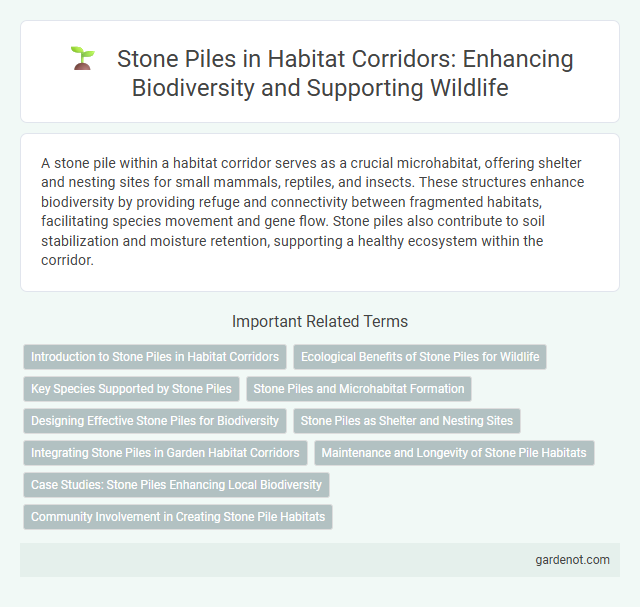A stone pile within a habitat corridor serves as a crucial microhabitat, offering shelter and nesting sites for small mammals, reptiles, and insects. These structures enhance biodiversity by providing refuge and connectivity between fragmented habitats, facilitating species movement and gene flow. Stone piles also contribute to soil stabilization and moisture retention, supporting a healthy ecosystem within the corridor.
Introduction to Stone Piles in Habitat Corridors
Stone piles serve as essential microhabitats within habitat corridors, providing shelter and breeding sites for small mammals, reptiles, and invertebrates. These structures contribute to biodiversity by offering refuge from predators and harsh weather, facilitating species movement and ecosystem connectivity. Integrating stone piles into corridor design enhances habitat complexity and supports conservation efforts through improved wildlife habitat quality.
Ecological Benefits of Stone Piles for Wildlife
Stone piles create essential microhabitats that provide shelter and nesting sites for small mammals, reptiles, and amphibians, enhancing local biodiversity. These structures promote thermal regulation by offering shaded and sun-exposed spots, critical for species survival in varying climates. Additionally, stone piles support insect populations that serve as food sources, fostering a balanced and thriving ecosystem within habitat corridors.
Key Species Supported by Stone Piles
Stone piles serve as critical microhabitats supporting key species such as reptiles, amphibians, and small mammals by providing shelter, breeding sites, and thermoregulation spots. Species like the Eastern Box Turtle, various salamander species, and small mammals like voles rely on stone piles for protection from predators and harsh environmental conditions. These structures enhance biodiversity within habitat corridors by creating essential refuges that facilitate species movement and genetic exchange.
Stone Piles and Microhabitat Formation
Stone piles create diverse microhabitats by providing shelter and stable temperature zones crucial for various small animals and plants. These structures enhance biodiversity by supporting insects, reptiles, and mosses that rely on the moisture and protection found within the crevices. Their role in habitat corridors is essential for facilitating species movement and ecological connectivity across fragmented landscapes.
Designing Effective Stone Piles for Biodiversity
Designing effective stone piles involves strategically arranging diverse rock sizes to create microhabitats that support amphibians, reptiles, and invertebrates. Positioning stones to maximize crevices and air pockets enhances shelter opportunities, moisture retention, and thermal regulation essential for species survival. Incorporating native vegetation around piles further promotes biodiversity by offering food sources and connectivity within habitat corridors.
Stone Piles as Shelter and Nesting Sites
Stone piles provide critical shelter and nesting sites for various wildlife species, offering protection from predators and harsh weather conditions. These structures create microhabitats that support amphibians, reptiles, small mammals, and insects, enhancing biodiversity within habitat corridors. Maintaining and restoring stone piles is essential for conserving species that rely on these unique refuges in fragmented landscapes.
Integrating Stone Piles in Garden Habitat Corridors
Stone piles provide essential microhabitats within garden habitat corridors, offering shelter and breeding sites for small mammals, reptiles, and invertebrates. By strategically placing stone piles along these corridors, gardeners enhance biodiversity and create connective habitats that facilitate species movement and genetic exchange. Incorporating native stones mimics natural environments, promoting ecological balance and supporting pollinator and predator populations in fragmented urban landscapes.
Maintenance and Longevity of Stone Pile Habitats
Regular inspection and careful removal of debris are essential for maintaining stone pile habitats, ensuring stable microclimates for reptiles and insects. Using durable, local stone materials enhances structural integrity and resistance to weathering, significantly extending habitat longevity. Proper arrangement that allows natural drainage prevents moisture buildup, reducing deterioration and promoting lasting ecological benefits.
Case Studies: Stone Piles Enhancing Local Biodiversity
Stone piles serve as critical microhabitats in habitat corridors, supporting diverse species such as reptiles, amphibians, and invertebrates by providing shelter and breeding grounds. Case studies from Mediterranean landscapes demonstrate that strategically placed stone piles increase local biodiversity by creating thermal refuges and promoting soil moisture retention. Research in Australian bushlands highlights stone piles' role in enhancing connectivity for small mammals, contributing to ecosystem stability and resilience.
Community Involvement in Creating Stone Pile Habitats
Community involvement in creating stone pile habitats fosters biodiversity by enabling local groups to contribute to conservation efforts that support small mammals, reptiles, and amphibians. Volunteers gather and arrange stones, ensuring suitable microhabitats that provide shelter, breeding grounds, and temperature regulation. Collaborative projects strengthen habitat corridors by connecting fragmented landscapes and enhancing ecosystem resilience.
Stone pile Infographic

 gardenot.com
gardenot.com